Overview
In the ever-evolving landscape of software development, developers often face significant challenges, particularly when it comes to managing complex codebases. How can one navigate these hurdles effectively? Enter Kodezi, a tool designed to tackle these coding challenges head-on. By focusing on key properties of Object-Oriented Programming (OOP) in Java—such as encapsulation, inheritance, polymorphism, and abstraction—Kodezi enhances the efficiency of software development.
The principles of OOP not only promote code reusability but also improve maintainability and security. With Kodezi, developers can leverage these properties to streamline their coding practices. Imagine being able to implement OOP principles seamlessly, resulting in cleaner, more efficient code. Furthermore, the integration of Kodezi into your development workflow can lead to significant productivity gains.
Why settle for less when you can elevate your coding experience? By utilizing Kodezi, you can enhance your code quality while reducing the time spent on debugging and maintenance. In addition, the tool provides valuable insights that can help you refine your programming practices, making it an essential asset for any developer.
Explore the features that Kodezi offers and discover how it can transform your approach to Object-Oriented Programming. With Kodezi, you can not only overcome common coding challenges but also set yourself up for long-term success in software development.
Introduction
In the realm of software development, coding challenges can often feel overwhelming for developers. Object-Oriented Programming (OOP) stands as a cornerstone of modern coding practices, offering a robust framework for organizing and managing complex systems. With principles like:
- Encapsulation
- Inheritance
- Polymorphism
- Abstraction
OOP empowers developers to create modular, reusable, and maintainable code. How can tools like Kodezi help address these challenges? By streamlining implementation and enhancing coding efficiency, Kodezi provides essential features that safeguard object integrity through encapsulation and promote code reusability via inheritance. Each of these concepts plays a vital role in shaping effective software solutions. As the industry evolves, understanding and leveraging these principles becomes essential for developers striving to produce high-quality, secure applications in an increasingly complex digital landscape. Explore the tools available on Kodezi to improve your productivity and elevate your coding practices.
Kodezi | Professional OpenAPI Specification Generator - AI Dev-Tool: Streamline Your OOPs Implementation
Developers often face significant challenges when effectively implementing the properties of OOPs in Java. Kodezi addresses these challenges with its powerful Professional OpenAPI Specification Generator, which automates the creation of API documentation. This automation is vital for preserving clarity and structure in programming. By integrating Kodezi into your workflow, you can streamline the implementation of the properties of OOPs in Java, including:
- Encapsulation
- Inheritance
- Polymorphism
This ultimately enhances your coding efficiency and productivity.
Moreover, Kodezi is an adaptable tool that not only streamlines the programming process but also ensures that your work conforms to professional standards. This facilitates easier management and maintenance over time. Furthermore, the Kodezi CLI’s autonomous capabilities, including the 'AutoHeal' feature, empower B2B engineering teams to improve code quality and fix bugs before they reach production. This significantly reduces the risk of security breaches, especially considering that 76% of security breaches occur due to outdated threat information. Kodezi's automation helps keep your codebases updated and secure.
Organizations that leverage automated tools for documentation and coding practices report a notable increase in efficiency. In fact, 61% of these organizations have noted improved incident detection, while 50% have experienced a reduction in response times to security threats. This underscores the importance of integrating advanced tools like Kodezi in modern software development. As Robert C. Martin aptly states, 'It means that a category should have one task to do,' highlighting the significance of focused category responsibilities in OOP, which reflects the properties of OOPs in Java and aligns perfectly with Kodezi's capabilities. Are you ready to enhance your coding practices? Explore the tools available on the Kodezi platform today!
Abstraction: Simplifying Complex Systems in Java OOPs
Coding challenges are a common hurdle for developers, particularly when managing complex systems. Abstraction in Java OOP offers a solution by allowing developers to focus on the essential characteristics of an object while concealing intricate implementation details. By utilizing abstract types and interfaces, developers create a framework that simplifies interactions with complex systems. For instance, a structure representing a vehicle can encapsulate common functionalities such as starting and stopping, while specific implementations for cars or bikes are defined in their respective subclasses. This approach not only mitigates complexity but also significantly boosts code reusability and maintainability.
The significance of abstraction extends beyond individual projects; it plays a crucial role in the broader software development landscape. With the global software industry projected to exceed $600 billion in revenue by 2024, managing complexity through abstraction is more vital than ever. Furthermore, statistics indicate that 74% of developers believe adopting agile methodologies, which often leverage abstraction, has greatly enhanced their capacity to navigate project uncertainties. Have you considered how the properties of OOP in Java, especially abstraction, could improve your own coding practices? Recent advancements in abstraction techniques in Java OOP have led to more efficient coding practices, allowing developers to create robust applications that are easier to maintain and scale. As the industry progresses, the trend of employing abstract structures and interfaces continues to gain traction, reflecting a collective shift towards simplifying complex systems in software development. By embracing these techniques, developers can enhance productivity and code quality, making their work more manageable and effective.
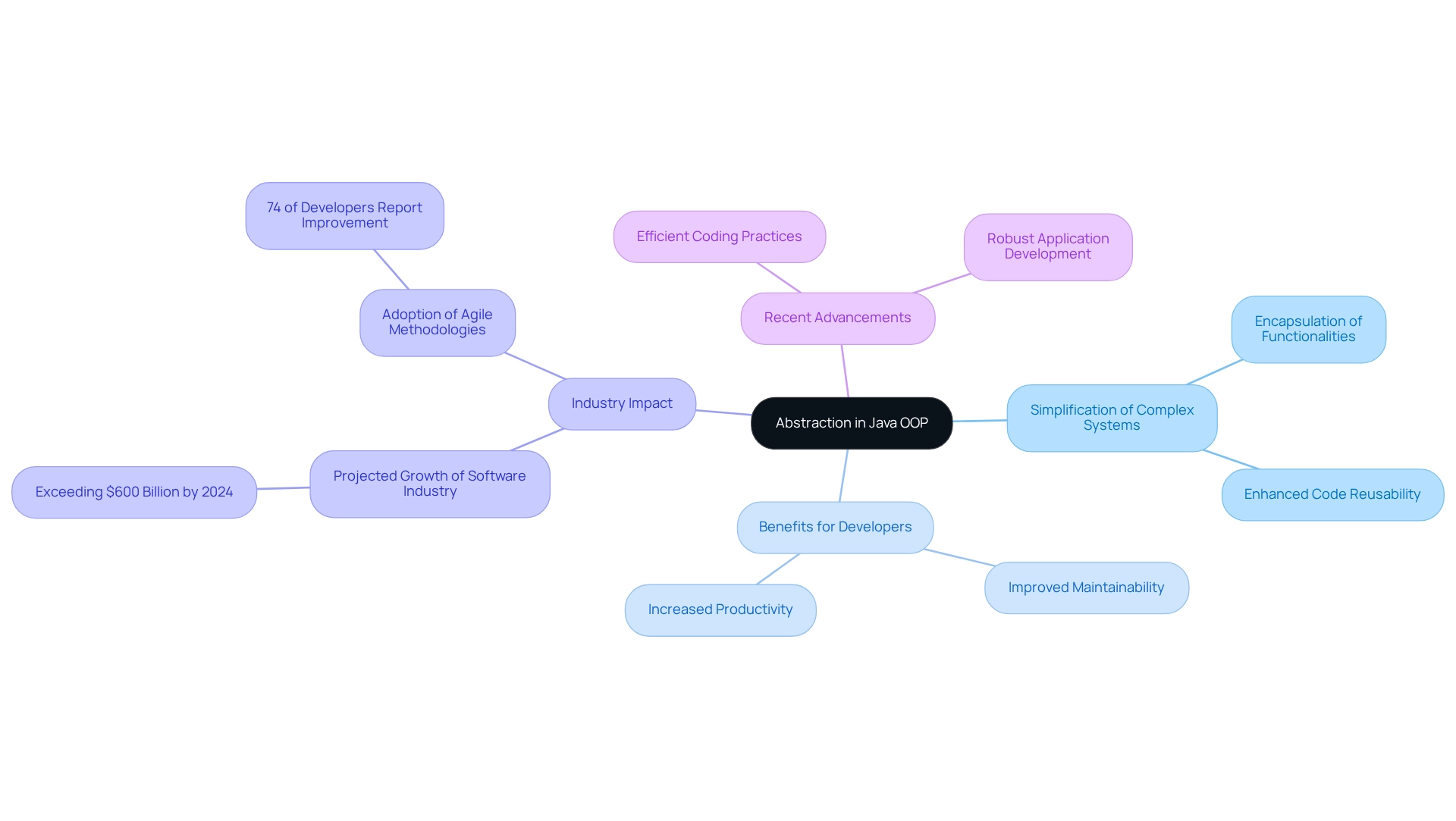
Encapsulation: Protecting Object Integrity in Java
Encapsulation is a fundamental concept in object-oriented programming that combines data (attributes) and functions within a single unit, or structure. In Java, this is typically achieved by declaring variables as private and providing public getter and setter methods for controlled access and modification. This practice safeguards the integrity of objects by limiting unauthorized access to their internal state.
Consider a BankAccount structure that encapsulates its balance attribute. By allowing deposits and withdrawals only through designated methods, the system ensures that the balance cannot be altered directly from outside, thereby maintaining its integrity.
Real-world applications of encapsulation further demonstrate its significance. For instance, a coffee machine illustrates how encapsulation conceals internal processes and ingredients from the user, facilitating interaction through well-defined interfaces. This approach not only improves usability but also protects sensitive data, underscoring the importance of encapsulation in software security.
Recent statistics reveal that encapsulation is vital for upholding software security, as it enhances maintainability and flexibility, resulting in more resilient applications. Studies indicate that encapsulation practices can lower the likelihood of security vulnerabilities by up to 30%. Best practices in Java programming endorse encapsulation as a strategy to protect object integrity, demonstrating the properties of OOP in Java and enabling developers to create secure and manageable codebases. By implementing encapsulation, developers effectively shield their applications from unauthorized access and modifications, ultimately fostering a more secure software environment. As one expert noted, "Encapsulation is essential because it standardizes how data is packaged and transmitted over networks, ensuring compatibility between different systems and protocols.
Inheritance: Promoting Code Reusability in Java OOPs
Inheritance stands as a fundamental concept in Java OOPs, allowing a new class, known as a subclass, to inherit the properties of OOPs in Java and behaviors from an existing class, referred to as a superclass. This principle highlights the properties of OOPs in Java by fostering functionality reusability, as shared features can be defined within the superclass and utilized across various subclasses.
For example, consider a superclass named Animal that includes functions like eat() and sleep(). You can then create subclasses such as Dog and Cat that inherit these functions without the need for repetition. This approach not only saves time but also enhances code maintainability and extensibility.
Polymorphism: Enhancing Flexibility in Java OOPs
Polymorphism in Java OOP represents a significant coding challenge for developers, as it denotes the ability of a single interface to embody various underlying forms or data types. This capability enables functions to perform different actions based on the object they interact with. The concept is classified into two primary categories:
- Compile-time polymorphism, achieved through function overloading.
- Runtime polymorphism, realized through function overriding.
For example, consider a superclass named Shape with a method called draw(). Subclasses like Circle and Square can implement their own versions of draw(), allowing a Shape reference to invoke the appropriate function based on the actual object type. This dynamic behavior not only enhances flexibility but also simplifies maintenance and reduces complexity.
Furthermore, recent trends indicate that in many software systems, at least 20% of functions utilize duck typing, showcasing the prevalence of polymorphism in modern development practices. This statistic underscores that polymorphism is not merely a theoretical concept, but a practical necessity in contemporary software design. The benefits of polymorphism extend beyond flexibility; it fosters code reusability and supports a more streamlined class design. As noted by Shailendra Chauhan, "A visionary leader, he continues to revolutionize technology education with his innovative approach," emphasizing the importance of adaptable coding practices.
In addition, practical applications, such as in management systems, illustrate how various subclasses can execute shared functions in distinct ways, ensuring that the appropriate behavior is carried out based on the object type. For instance, a case study on management systems demonstrates how subclasses can customize their implementations of common methods, enhancing overall functionality and maintainability. As the landscape of software development evolves, the importance of polymorphism in enhancing flexibility and maintainability is continually emphasized by industry experts, highlighting its role in creating robust and efficient code.
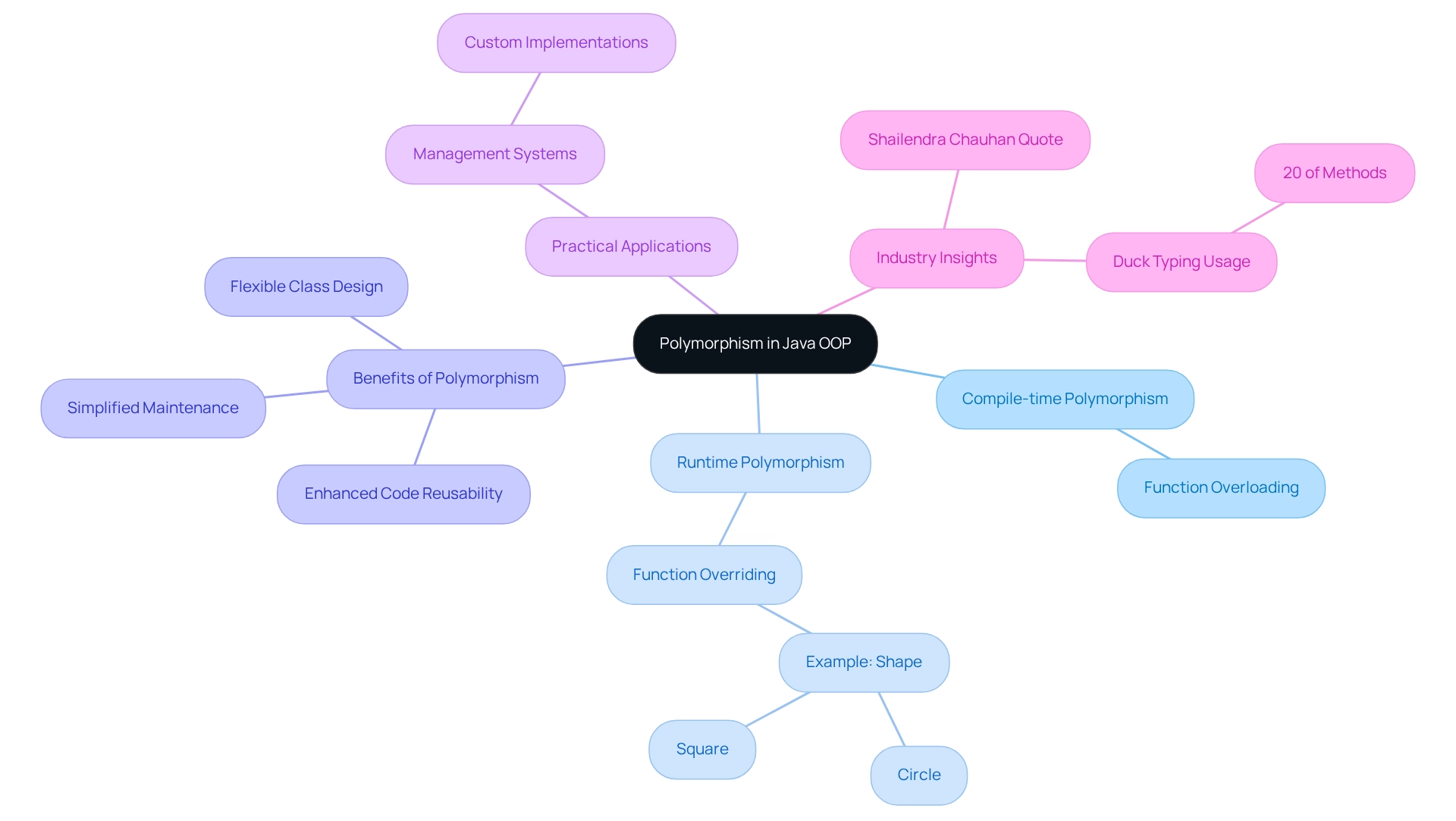
Classes and Objects: The Building Blocks of Java OOPs
In Java, the properties of OOP in Java, such as types and instances, serve as the foundational elements of Object-Oriented Programming (OOP). They act as templates for generating instances, outlining their characteristics (attributes) and actions (methods). A thing is an example of a category, representing a particular entity with its own condition. For example, if you possess a type named Car, you can generate several instances such as myCar and yourCar, each with distinct characteristics like color and model. This encapsulation of data and behavior allows for improved organization and modularity in programming, making it easier to manage and extend.
The significance of the properties of OOP in Java, including types and instances, cannot be overstated. They empower developers to construct modular structures, which are crucial for maintaining and scaling applications. As industry experts note, modularity is essential for efficient programming, facilitating easier debugging and enhancement of codebases. Colin Sullivan emphasizes that "generally, until you understand why you need static methods/attributes, avoid using them," underscoring the importance of grasping modularity in Java programming.
Recent trends in OOP education highlight the necessity of understanding these concepts, particularly in practical applications. For instance, a case study on serialization and deserialization in Java demonstrates how entities can be stored to and retrieved from files. This emphasizes the need for types to implement the Serializable interface for effective serialization. Such case studies illustrate how modularity and structure in programming can facilitate effective data management.
Statistics indicate that a functional interface in Java includes solely one abstract method, emphasizing the simplicity that entities and instances offer in OOP. This simplicity is vital for developers aiming to boost productivity and ensure code quality. Overall, the properties of OOP in Java, including the role of types and objects, are crucial for providing the foundation for effective development and robust software design.
Method Overloading: Creating Versatile Methods in Java
Developers often face challenges when writing code that is both efficient and easy to read. Function overloading in Java addresses these challenges by allowing a class to define multiple functions with the same name but differing parameter lists. This feature significantly enhances the readability and usability of programs, enabling similar operations to be performed under a unified name. For instance, consider a function named add() that can accept two integers, three integers, or two doubles. This flexibility exemplifies how function overloading simplifies programming by reducing the need for multiple function names, making it easier for developers to grasp and utilize a class's functionality.
As repositories grow, maintaining clean code becomes essential. Function overloading contributes to this by allowing developers to eliminate functions with similar signatures, ultimately streamlining their codebases. Recent studies underscore that function overloading enhances software usability, with experts noting improvements in readability through versatile functions that accommodate various input types. In a case study focused on programming adaptability and clarity, it was found that overloaded functions serve as different iterations of the same capability, facilitating easier writing and maintenance.
Moreover, the trend towards enhancing script clarity through function overloading is gaining traction. Programmers are increasingly recognizing its advantages, as adopting this practice enables them to create adaptable strategies that not only improve code clarity but also foster better collaboration and understanding among team members. In summary, function overloading is a vital characteristic among the properties of oops in Java, driving efficiency and effectiveness in software development.
Method Overriding: Achieving Runtime Polymorphism in Java
Function overriding is a key concept in object-oriented programming that addresses a common coding challenge: how to customize behavior in subclasses. When a subclass provides a specific implementation for a method already defined in its superclass, it enables runtime polymorphism. This means that the method executed is determined at runtime based on the type of the object instance.
Consider a superclass named Animal with a method sound(). Subclasses like Dog and Cat can override this method to deliver their unique implementations. For instance, when you call sound() on an Animal reference pointing to a Dog object, the Dog's version of sound() is executed. This scenario illustrates the power of polymorphism, enhancing flexibility in coding practices.
Furthermore, understanding function overriding not only improves code organization but also facilitates easier maintenance and scalability. Have you considered how this concept could streamline your coding projects? By leveraging such features, developers can create more robust and adaptable applications.
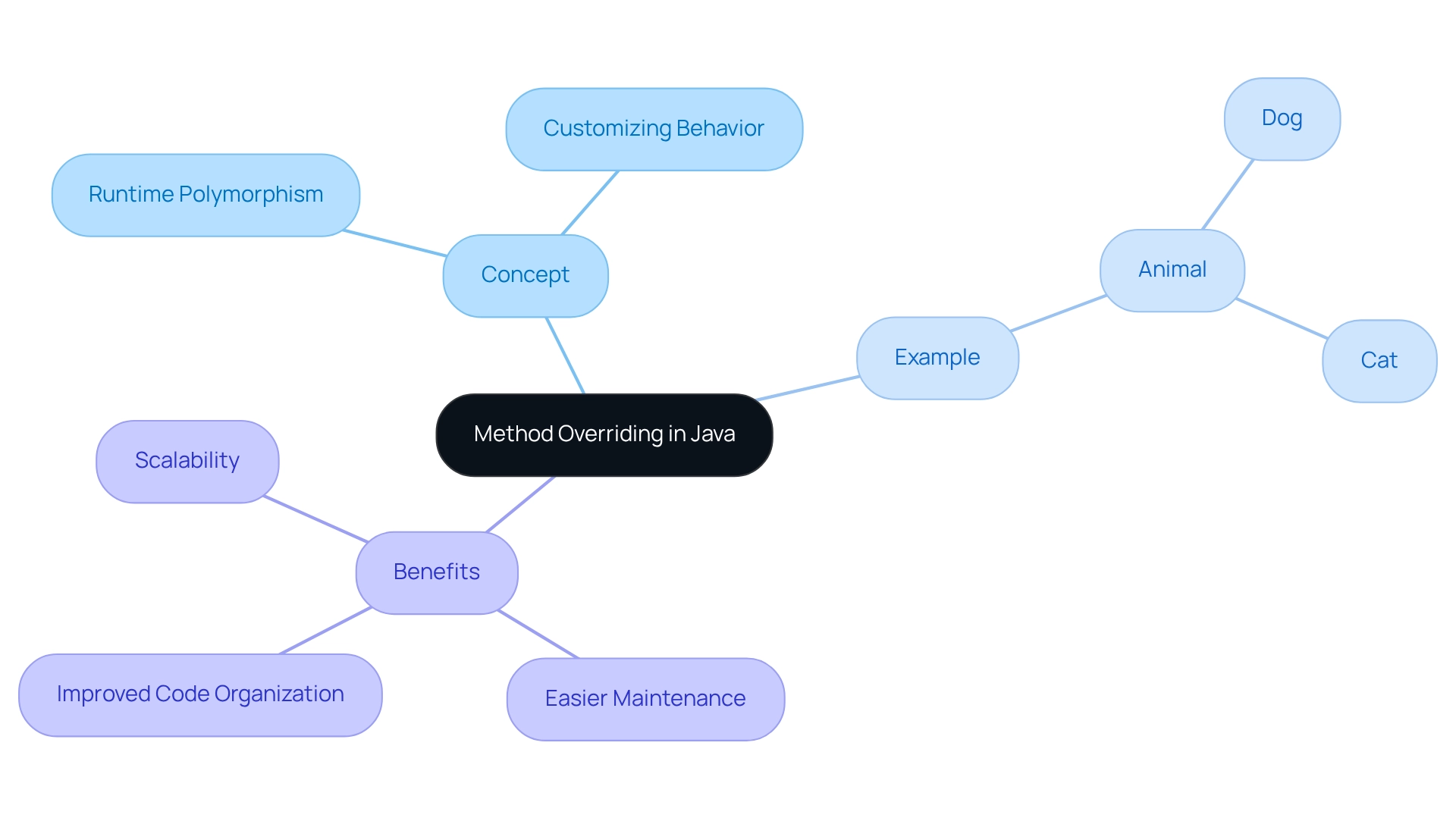
Interfaces: Defining Contracts for Java Classes
In the realm of Java programming, developers often encounter challenges related to code structure and flexibility. An interface serves as a reference type that specifies a collection of abstract functions that a type must implement. By permitting multiple inheritance, interfaces allow a type to implement several interfaces, enhancing both flexibility and modularity in design.
For instance, consider an interface named Drawable that features a function draw(). Any entity implementing this interface is required to supply an implementation for draw(). This guarantees that all implementing classes adhere to a common contract, simplifying the management and extension of the codebase while promoting code reusability.
Understanding how to effectively utilize interfaces can significantly improve your coding practices and overall productivity.
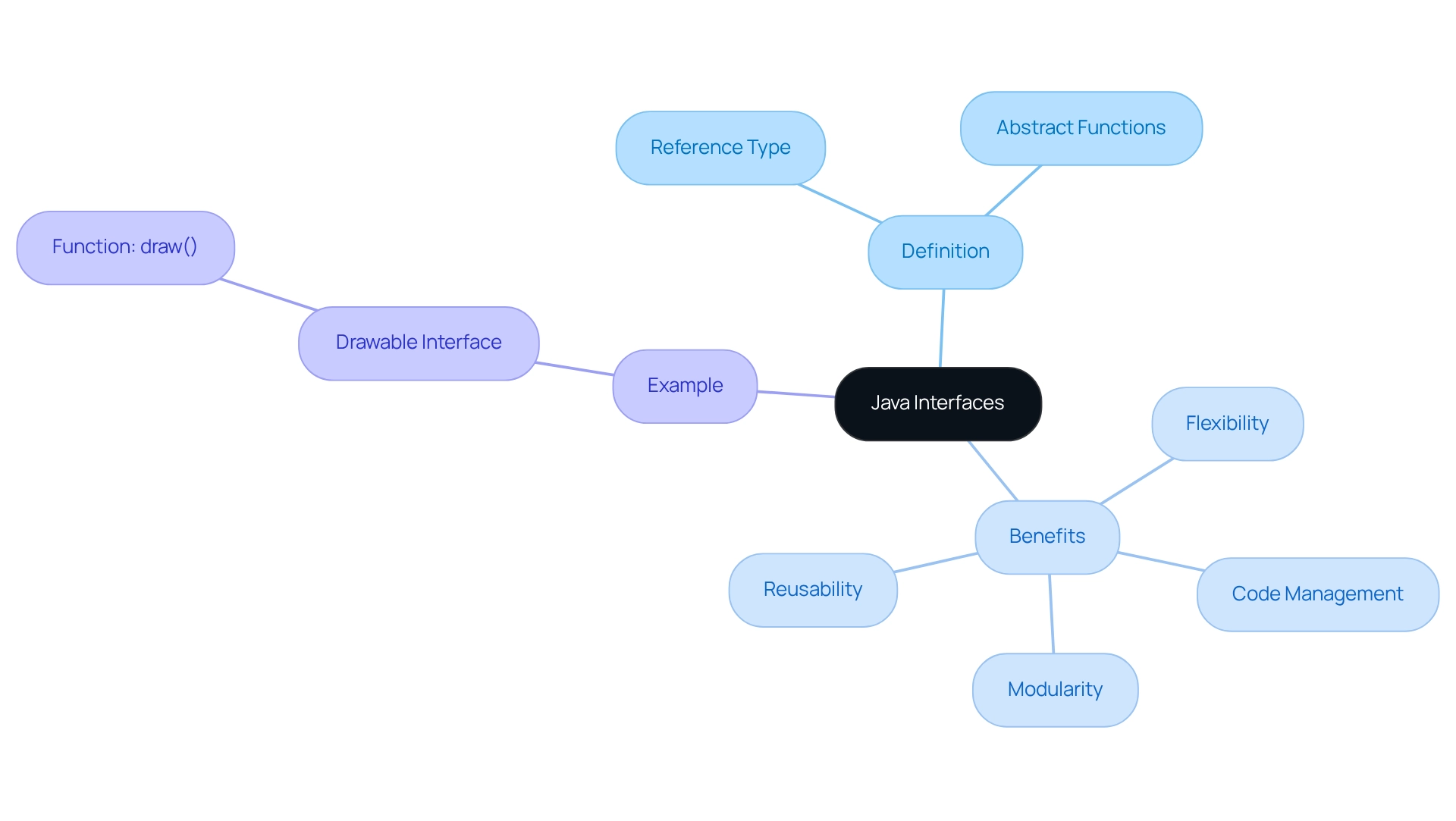
Dynamic Binding: Resolving Method Calls at Runtime in Java OOPs
Dynamic binding, often known as late binding, represents a crucial mechanism in Java that addresses common coding challenges developers face. This approach allows the function to be determined at runtime rather than compile time.
Why is this important? In the realm of polymorphism, the specific function executed depends on the runtime type of the entity. For example, consider a superclass Shape with a method draw(), and its subclasses Circle and Square that override this method. The Java Virtual Machine (JVM) dynamically identifies which draw() method to invoke based on the actual object type at runtime.
This capability not only enhances code flexibility but also fosters the development of more dynamic and adaptable applications. By leveraging dynamic binding, developers can significantly improve their productivity and code quality.
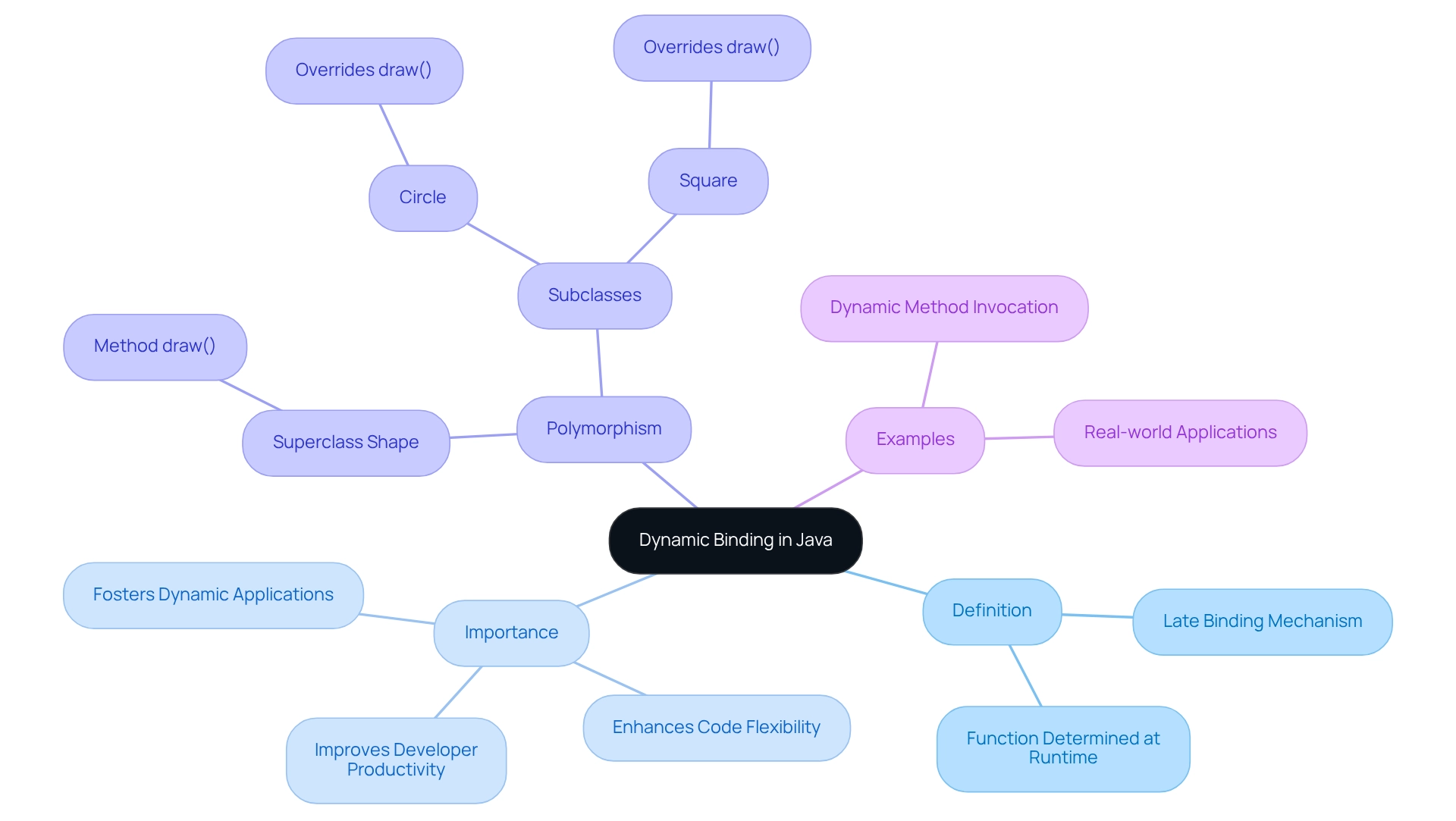
Conclusion
Integrating Object-Oriented Programming (OOP) principles into software development is crucial for tackling the coding challenges developers encounter today. As applications become increasingly complex, the need for efficient, maintainable, and secure solutions is paramount. Kodezi emerges as a powerful tool that addresses these challenges, offering features that streamline coding practices and enhance productivity.
By leveraging encapsulation, inheritance, polymorphism, and abstraction, Kodezi empowers developers to manage complexity effectively. Encapsulation safeguards object integrity, controlling access to class attributes. Inheritance facilitates the reuse of common functionalities across subclasses, significantly reducing redundancy. Furthermore, polymorphism enhances flexibility, allowing methods to operate on various data types, which fosters a dynamic coding approach that simplifies maintenance. Abstraction enables developers to concentrate on essential characteristics, a necessity in an industry characterized by ever-increasing complexity.
The advantages of embracing these OOP principles and utilizing tools like Kodezi are clear. Not only can they improve coding efficiency, but they also reduce security vulnerabilities and enhance overall software quality. As the software development landscape evolves, prioritizing these methodologies becomes essential for navigating modern programming challenges. Ultimately, this leads to the creation of high-quality, secure applications in a competitive digital environment. Explore the tools available on Kodezi to elevate your coding practices and achieve better results.
Frequently Asked Questions
What challenges do developers face when implementing OOP properties in Java?
Developers often encounter significant challenges in effectively implementing the properties of OOPs in Java, such as encapsulation, inheritance, and polymorphism.
How does Kodezi help in implementing OOP properties in Java?
Kodezi addresses these challenges by providing a Professional OpenAPI Specification Generator that automates API documentation, streamlining the implementation of OOP properties and enhancing coding efficiency and productivity.
What are the key properties of OOPs mentioned in the article?
The key properties of OOPs mentioned are encapsulation, inheritance, and polymorphism.
What is the importance of automation in programming according to the article?
Automation is vital for preserving clarity and structure in programming, facilitating easier management and maintenance over time, and keeping codebases updated and secure.
What features does Kodezi offer to improve code quality?
Kodezi offers autonomous capabilities, including the 'AutoHeal' feature, which empowers engineering teams to improve code quality and fix bugs before they reach production.
How does Kodezi contribute to security in software development?
Kodezi's automation helps reduce the risk of security breaches by keeping codebases updated, which is crucial since a significant percentage of security breaches occur due to outdated threat information.
What benefits do organizations experience by using automated tools like Kodezi?
Organizations that leverage automated tools for documentation and coding practices report increased efficiency, improved incident detection, and reduced response times to security threats.
How does abstraction in Java OOP help developers?
Abstraction allows developers to focus on essential characteristics of an object while concealing complex implementation details, which simplifies interactions with complex systems and enhances code reusability and maintainability.
Why is encapsulation important in object-oriented programming?
Encapsulation combines data and functions within a single unit, safeguarding the integrity of objects by limiting unauthorized access to their internal state and enhancing software security.
What real-world example illustrates the concept of encapsulation?
A coffee machine is an example of encapsulation, as it conceals internal processes and ingredients from the user while facilitating interaction through well-defined interfaces.
What are the reported statistics regarding encapsulation's impact on software security?
Studies indicate that encapsulation practices can lower the likelihood of security vulnerabilities by up to 30%, highlighting its importance in maintaining software security.




